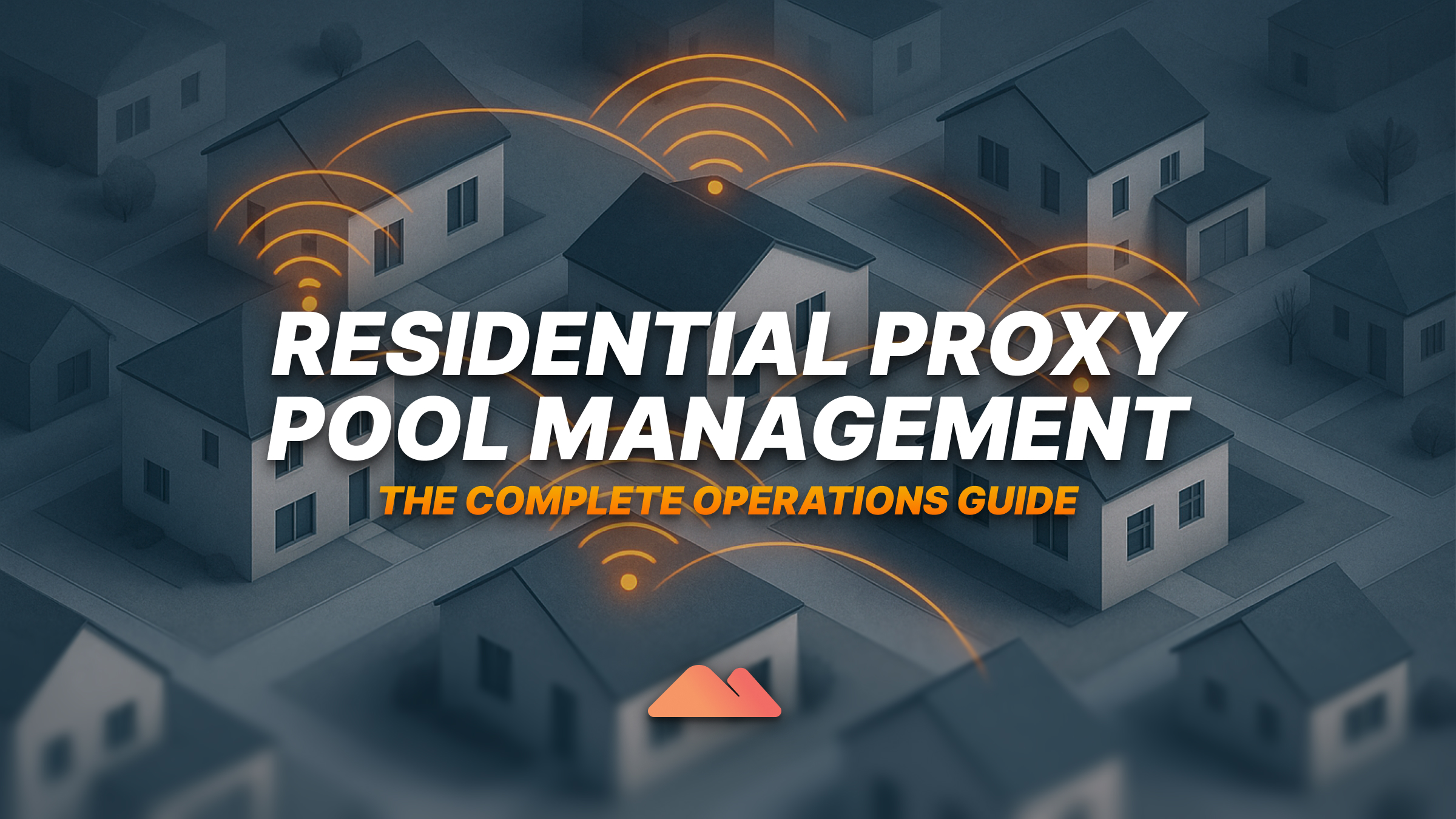TL;DR
Residential proxy pool management is the strategic operation of thousands to millions of legitimate residential IP addresses to enable large-scale data collection. Success requires multi-dimensional pool segmentation (performance tiers, ISP diversity, geographic accuracy), continuous quality monitoring (85%+ success rates on e-commerce, 78%+ on social media), and sophisticated rotation strategies.
Key operational requirements include automated quality scoring, compliance frameworks for GDPR/CCPA, and machine learning-driven IP selection. Most operations fail due to poor segmentation, inadequate monitoring, or treating proxy management as a commodity rather than a core competency requiring dedicated infrastructure and expertise.
What is a Proxy Pool?
A proxy pool is a managed collection of proxy servers that act as intermediaries between your applications and target websites, providing redundancy, scalability, and distributed request handling essential for enterprise data collection operations. While proxy pools serve various functions across different industries, this guide focuses specifically on the advanced management strategies required for residential proxy operations at scale.
Residential proxy pools differ fundamentally from traditional datacenter pools by sourcing IPs from legitimate home internet connections. Understanding what makes a residential proxy unique is crucial for effective pool management, as these pools contain IP addresses assigned by major ISPs to actual residential customers who've consented to share their connection. This authenticity makes residential pools significantly more effective for accessing protected content, but introduces complexity in management, compliance, and operational consistency that requires sophisticated handling.
Modern residential proxy pools operate as distributed systems combining multiple infrastructure layers: IP source management handling 50,000 to 500,000+ residential endpoints, gateway infrastructure managing request routing and load balancing, and intelligent management layers providing quality scoring, geographic routing, and compliance monitoring.
The most valuable characteristic of residential pools is their behavioral authenticity—these IPs have legitimate browsing history, cookies from real user sessions, and behavioral patterns matching genuine consumer internet usage. However, unlike datacenter proxies with consistent performance, residential endpoints exhibit dynamic availability based on user activity patterns and performance variability depending on connection quality and network congestion.
Managing residential proxy pools at scale isn't just about having thousands of IPs—it's about orchestrating a complex ecosystem that delivers consistent performance while maintaining the authenticity that makes residential proxies invaluable. This comprehensive guide breaks down the strategic and tactical elements that separate successful operations from those that struggle with blocks, compliance issues, and poor ROI.
The Foundation: Pool Architecture and Segmentation
Core Pool Components
Modern residential proxy pools operate on three foundational layers that work together to create authentic, scalable infrastructure:
Peer-to-Peer Network Layer forms the primary IP source, typically representing 60-70% of most high-quality pools. These IPs come from legitimate residential users who've opted into sharing their connection. The key metrics here include geographic distribution, ISP diversity, and user retention rates. Top-tier providers maintain over 85% user retention monthly, indicating sustainable compensation models and minimal user impact.
Carrier-Grade NAT (CGN) Layer provides 20-25% of IPs that offer higher stability and predictable performance. While less "residential" in the traditional sense, CGN endpoints from major ISPs provide crucial stability for long-running sessions. These IPs typically show 40-60 minute average session lengths compared to 8-15 minutes for standard residential endpoints.
Mobile Network Integration represents the fastest-growing segment at 10-15% of premium pools. Mobile proxies offer unique advantages for mobile-first platforms but require sophisticated rotation strategies due to their dynamic nature. Mobile endpoints show 23% higher success rates on social media platforms but 15% lower performance on traditional e-commerce sites.
Strategic Segmentation Framework
Effective segmentation goes far beyond geographic distribution. The most successful operations implement multi-dimensional segmentation based on:
Performance Tiers: Classify IPs into Gold (95%+ success rate), Silver (85-94% success rate), and Bronze (75-84% success rate) categories. Gold tier IPs, representing roughly 15-20% of most pools, get reserved for high-value operations where failure isn't acceptable. Silver tier handles standard operations, while Bronze tier serves development and testing environments.
Target-Specific Categories: Different websites require different IP characteristics. Social media platforms favor mobile and residential IPs with consistent user agents, while e-commerce sites perform better with desktop-pattern IPs showing longer session durations. SEO monitoring benefits from IPs with minimal previous search activity.
ISP-Based Segmentation: Major ISPs like Comcast, Verizon, and AT&T each have different characteristics and detection tolerances. Comcast endpoints typically show 18% better performance on streaming platforms, while Verizon IPs excel for financial services data collection.
Quality Metrics and Monitoring
Essential Performance Indicators
Success Rate by Target Domain provides the most actionable insight into pool quality. Track this metric across at least 50 major domains in your target categories. A healthy residential pool should maintain 85%+ success rates across mainstream e-commerce sites, 78%+ on social media platforms, and 92%+ on general news and information sites. These benchmarks align with industry performance standards for residential proxy operations.
Response Time Consistency matters more than raw speed for residential proxies. Standard deviation should remain below 500ms for 90% of requests within the same geographic region. Inconsistent response times often indicate infrastructure problems or IP reputation issues that will escalate into blocks.
Geographic Accuracy Verification requires continuous monitoring against multiple geolocation databases. MaxMind, IP2Location, and IPinfo should agree on location within 50 miles for at least 95% of your pool. Mismatched geolocation data triggers sophisticated detection systems used by major platforms.
Advanced Quality Scoring
Implement a composite quality score combining multiple factors:
- Historical Success Rate (40% weight): Rolling 7-day success percentage across all operations
- Geographic Accuracy (25% weight): Consistency across geolocation databases
- Behavioral Consistency (20% weight): Response patterns that match expected residential behavior
- Reputation Status (15% weight): Absence from major blocklists and anti-fraud databases
IPs scoring below 70 should be automatically quarantined for review, while those above 85 get priority allocation for critical operations.
Real-Time Monitoring Implementation
Deploy monitoring probes that test pool health every 15 minutes across representative target sites. Key monitoring points include:
- Authentication Success: Can IPs successfully complete login flows on major platforms?
- CAPTCHA Frequency: How often do requests trigger CAPTCHA challenges?
- Rate Limiting Thresholds: At what request frequency do sites begin blocking IPs?
- Session Persistence: Do IPs maintain consistent behavior across extended sessions?
Use Case Deep Dives
E-commerce Price Monitoring
Challenge: Retail sites implement sophisticated bot detection combining IP reputation, browsing patterns, and request timing analysis.
Pool Requirements:
- Minimum 10,000 IPs per major geographic market
- ISP diversity with no single provider exceeding 15% of regional allocation
- Session persistence capability for 20-45 minutes
- Mobile IP allocation of at least 30% to match shopping patterns
Operational Strategy: Implement staggered request timing that mimics human browsing behavior. Requests should arrive with 15-45 second intervals with random variance. Maintain shopping cart sessions for 15-20 minutes before rotation to avoid triggering abandonment detection systems. For organizations new to residential proxy operations, proper implementation techniques are essential for achieving these behavioral patterns while avoiding common configuration mistakes that lead to blocks.
Success Metrics: Target 88%+ success rate on tier-1 retailers (Amazon, Walmart, Target), with no single IP generating more than 50 requests per hour per domain.
Social Media Intelligence
Challenge: Social platforms employ machine learning models that analyze user behavior patterns, device fingerprints, and network characteristics to identify automated access.
Pool Requirements:
- Heavy mobile IP allocation (60%+ of requests)
- Geographic clustering that matches platform demographics
- Support for persistent sessions lasting 45-90 minutes
- Integration with residential user-agent rotation
Operational Strategy: Maintain consistent user personas across sessions, including browser fingerprints, time zone behavior, and interaction patterns. Space interactions 2-8 minutes apart with realistic engagement patterns, including scrolling simulation and varied content interaction.
Success Metrics: Achieve 82%+ success rate on major platforms with average session lengths exceeding 35 minutes before rotation.
Performance Data: Operations using mobile-heavy residential pools show 34% fewer blocks on Instagram and 28% fewer on TikTok compared to desktop-only approaches, with session lengths averaging 47 minutes vs 23 minutes for mixed mobile/desktop strategies.
SEO and SERP Monitoring
Challenge: Search engines implement query pattern analysis and geographic consistency validation that can detect automated monitoring systems.
Pool Requirements:
- True geographic distribution matching target search markets
- Low query frequency per IP (maximum 12 searches per IP per day)
- Mixed device types reflecting natural search behavior
- Clean IP history with minimal previous search activity
Operational Strategy: Distribute queries across geographic regions during local peak hours. Implement realistic search patterns including related queries, result page browsing, and occasional non-target searches, to maintain behavioral authenticity.
Success Metrics: Maintain 94%+ success rate with consistent ranking data across geographic markets.
Optimization Results: A SERP monitoring operation reduced false positives by 67% when they implemented timezone-aware query distribution, ensuring searches occurred during realistic hours for each geographic market.
Market Research and Lead Generation
Challenge: B2B platforms and professional networks implement complex detection systems analyzing connection patterns, profile interaction frequency, and cross-platform behavioral correlation.
Pool Requirements:
- Enterprise ISP allocation reflecting business internet patterns
- Extended session capability (60-120 minutes)
- Geographic accuracy at the city level for location-based targeting
- Integration with professional browsing pattern simulation
Operational Strategy: Mirror professional browsing behavior with longer page dwell times, document downloads, and realistic navigation patterns. Maintain consistent professional personas across extended research sessions.
Success Metrics: Target 76%+ success rate on professional platforms with average session research productivity of 40+ data points per session.
Scaling Operations
Infrastructure Requirements by Scale
Small Operations (1-10M requests/month):
- Minimum 5,000 residential IPs across 3+ countries
- Basic rotation logic with 15-minute session persistence
- Manual quality monitoring with weekly pool health reports
- Geographic distribution: 60% US, 25% EU, 15% other major markets
Medium Operations (10-100M requests/month):
- 25,000+ residential IPs with city-level geographic control
- Automated quality scoring and IP quarantine systems
- Target-specific pool segmentation with performance optimization
- Advanced session management supporting multiple concurrent operations
Large Operations (100M+ requests/month):
- 100,000+ residential IPs with comprehensive global coverage
- Machine learning-based IP selection and rotation optimization
- Real-time performance monitoring with automated scaling
- Compliance automation with regulatory requirement tracking
Real-World Pool Growth Examples
The demand for residential proxy pools has grown exponentially as data collection requirements become more sophisticated. Massive's residential IP pool demonstrates this trend, expanding from 50,000 IPs globally in November 2023 to over 1.6 million IPs by July 2025—a 3,100% increase in just 20 months. The US market alone has grown from 3,000 daily IPs in April 2024 to nearly 400,000 daily IPs, while international coverage now spans 1.2 million IPs across key global markets.
%2520(EN).png)
This explosive growth illustrates why automated pool management becomes critical at enterprise scale. Managing 396,000+ daily US IPs and 1.2M+ international endpoints requires sophisticated automation for quality scoring, geographic distribution, ISP diversity management, and real-time performance optimization.
Automated Pool Management
Implement automated systems that handle routine management tasks:
Quality Assessment Automation: Deploy scripts that test random IP samples every 2 hours against a standardized target set. Automatically quarantine IPs showing a decline in success rates or unusual response patterns.
Load Distribution Intelligence: Use algorithms that consider IP freshness, recent success history, and target-specific performance when allocating requests. Successful systems achieve 15-25% better resource utilization compared to simple round-robin approaches.
Predictive Maintenance: Analyze IP performance trends to predict failures before they impact operations. IPs showing declining performance over 72 hours typically require 48-hour cooling periods to restore full effectiveness.
Performance Optimization Strategies
Session Optimization: Maintain detailed analytics on optimal session lengths by target type. E-commerce monitoring performs best with 25-35 minute sessions, while social media intelligence benefits from 45-75 minute sessions.
Request Timing Intelligence: Implement sophisticated timing that accounts for target server load patterns, geographic time zones, and realistic user behavior. Peak performance occurs when request timing matches expected user activity patterns for each IP's claimed location.
Failure Recovery Automation: Build systems that automatically retry failed requests using different IP segments. Implement exponential backoff with intelligent IP selection that avoids recently failed endpoints.
Compliance and Risk Management
Regulatory Compliance Framework
Data Protection Compliance: GDPR and CCPA requirements extend to proxy operations when personal data is collected through residential IPs. Implement data minimization principles and ensure all collected data has a legitimate business purpose with appropriate retention policies.
Peer Network Ethics: Maintain transparent user consent processes and fair compensation models. Top-performing peer networks show 90%+ user satisfaction scores and voluntary retention rates exceeding 85%.
Geographic Compliance: Different jurisdictions have varying requirements for proxy operations. EU operations require explicit user consent and data processing agreements, while some Asian markets have restrictions on cross-border data collection.
Risk Mitigation Strategies
IP Reputation Monitoring: Continuously monitor your pool against major blocklists and reputation databases. Implement automated removal of IPs appearing on Spamhaus, SURBL, or other major reputation systems.
Rate Limiting Enforcement: Implement both per-IP and per-target rate limiting that prevents individual operations from burning valuable IPs through excessive request volumes.
Audit Trail Maintenance: Keep comprehensive logs of IP allocation, request patterns, and success/failure rates for compliance reporting and operation optimization.
Advanced Optimization Techniques
Machine Learning Integration
Predictive IP Selection: Train models on historical performance data to predict which IPs will succeed for specific targets. Advanced systems achieve 20-30% improvement in first-request success rates.
Behavioral Pattern Optimization: Use ML to identify and replicate successful browsing patterns that avoid detection. Models trained on successful sessions can guide request timing and interaction patterns.
Anomaly Detection: Deploy systems that identify unusual patterns in IP performance or target responses that might indicate emerging detection systems or pool quality issues.
Integration Strategies
CRM and Sales Intelligence Integration: Combine residential proxy operations with customer relationship management systems to enhance lead quality and reduce detection risks during prospect research.
Business Intelligence Platform Connection: Feed proxy performance data into broader BI systems to identify correlations between data collection success and business outcomes.
Compliance Management Integration: Connect proxy operations with compliance management platforms to ensure regulatory requirements are met across all data collection activities.
Wrapping-Up
The complexity of residential proxy pool management continues to increase as both technology and regulations evolve. Organizations that invest in sophisticated management systems, comprehensive compliance frameworks, and continuous optimization processes will maintain competitive advantages while those treating proxy management as a simple technical implementation will struggle with performance, compliance, and cost issues.
Success in residential proxy pool management requires treating it as a core operational competency rather than a commodity service. The strategies outlined in this guide reflect lessons learned from managing pools at various scales, from startup operations to enterprise providers like Massive, whose residential proxy infrastructure serves clients across industries requiring reliable, compliant data collection solutions.
The frameworks and best practices detailed here provide the foundation for building scalable, compliant, and high-performing proxy operations that deliver consistent business value in an increasingly sophisticated landscape.

I am the co-founder & CEO of Massive. In addition to working on startups, I am a musician, athlete, mentor, event host, and volunteer.
Customer reviews
Frequently Asked Question
What size residential proxy pool do I need for my operation?
+
Pool size depends on request volume and target diversity. Basic operations (under 1M requests monthly) need 5,000-10,000 IPs. Medium-scale operations (10-100M requests) require 25,000-50,000 IPs. Enterprise operations (100M+ requests) need 100,000+ IPs. Quality segmentation across ISPs and regions matters more than raw size—a well-managed 20,000 IP pool often outperforms a poorly managed 100,000 IP pool.
How do I measure residential proxy pool quality?
+
Track success rates by target domain: aim for 85%+ on e-commerce sites, 78%+ on social media, 92%+ on general content sites. Monitor geographic accuracy (95%+ agreement across geolocation databases), response time consistency (under 500ms standard deviation), CAPTCHA frequency, and IP reputation scores. Implement automated quality scoring combining these metrics with weighted importance based on your use cases.
What's the difference between sticky sessions and rotating IPs?
+
Sticky sessions maintain the same IP for 10-60 minutes, ideal for e-commerce monitoring and authenticated sessions requiring behavioral consistency. Rotating IPs change with each request, better for high-volume operations needing request distribution. Most successful operations combine both strategies—sticky sessions for specific workflows, intelligent rotation for background operations.
How do I ensure compliance when using residential proxy pools?
+
Ensure your provider obtains explicit user consent for GDPR/CCPA compliance. Implement data minimization principles and clear retention policies. Maintain comprehensive audit trails of IP allocation and data collection activities. Consider industry-specific regulations (PCI DSS, HIPAA) and conduct regular compliance reviews. Legal consultation helps navigate evolving regulatory requirements across jurisdictions.
What causes residential proxy IPs to get blocked?
+
Common causes include excessive request rates (limit to 20-50 requests per hour per IP per domain), unusual browsing patterns, geographic inconsistencies between IP location and user behavior, IP reputation issues from previous abuse, and poor session management creating unnatural behavior patterns. Prevention requires intelligent rate limiting, realistic behavior simulation, and continuous IP reputation monitoring.
How much should I expect to pay for quality residential proxy pools?
+
Budget providers: $3-8 per GB (poor performance, high block rates). Standard proxies: $10-20 per GB (reasonable quality, basic features). Premium pools: $25-50 per GB (superior success rates, advanced targeting, comprehensive compliance). Consider total cost of ownership including infrastructure and operational overhead. Higher-quality pools typically deliver better ROI through reduced complexity and higher success rates.
Can I mix residential and datacenter proxies in the same operation?
+
Yes, when implemented strategically. Use residential proxies for high-protection targets with sophisticated bot detection, datacenter proxies for less sensitive operations requiring speed and lower cost. Never mix proxy types against the same target domains. Maintain strict separation by target type, geographic region, or operational phase. Ensure your infrastructure can manage different authentication methods and rotation strategies simultaneously.
How do I handle proxy pool performance issues?
+
Start by segmenting performance data by geographic region, ISP, and target domain to identify problem areas. Implement automated monitoring testing pool health every 15 minutes. Check IP reputation against major blocklists, analyze request patterns for rate limiting violations, and consider cooling periods for overused IPs. Maintain detailed performance baselines to identify trends before they significantly impact operations.









.jpg)
